![]()
![]()
![]()
Use LEFT and RIGHT arrow keys to navigate between flashcards;
Use UP and DOWN arrow keys to flip the card;
H to show hint;
A reads text to speech;
17 Cards in this Set
- Front
- Back
|
Which three indications can be displayed after passing a Clear Normal Speed? |
Clear normal speed. Reduce to medium. Normal speed warning. |
|
|
What is the maximum speed a train can proceed at when passing a signal displaying Clear Medium Speed? |
The track section ahead is clear but the speed of the train must not exceed 40km/h. The next fixed signal will display a proceed indication for medium or normal speed. Unless the is an illuminated speed. |
|
|
True/ false. A clear low speed can be displayed on an Automatic signal? |
False. |
|
|
True/ false. A low speed caution indication displayed on a three position home signal controls train movements to any track protected by that signal? |
True. |
|
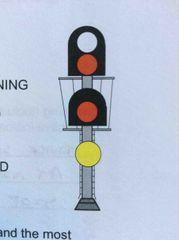
Explain this signal. |
Home signal at Low speed caution. The section of line ahead may be occupied or obstructed. The driver must proceed at low speed (15km/h) prepared to stop short of any obstruction. The points are locked and set for the movement. |
|
|
After passing a clear medium speed indication, for how long must the driver operate the train at 40km/h? |
Until the next fixed signal is reached. |
|
|
Why are co-acting signals used? |
Allows train crew sight to a fixed signal that has been obscured by buildings, trees or infrastructure. |
|
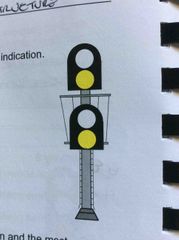
What type of signal is this and describe how the driver interprets is the indication. What two other indications can it display? |
Repeating signal at warning. The track section ahead is clear and the train may proceed at normal speed. However, the driver must be prepared to stop at the next fixed signal. •Reduce to medium. •Proceed |
|

Interpret this signal. |
Automatic signal at Normal speed warning. The track section ahead is clear and the train may proceed at normal speed, but the driver must be prepared to stop at the next fixed signal. |
|

Interpret this signal. |
Automatic signal at Reduce to medium. The track section ahead is clear and the train may proceed at normal speed but must reduce to medium speed before next fixed signal. |
|

Interpret this signal. |
Home signal at Clear medium speed. The track section ahead is clear but the speed of the train must not exceed 40km/h. The next fixed signal will be displaying a proceed indication. Can increase speed on mainline after rear of train has exited loop. |
|
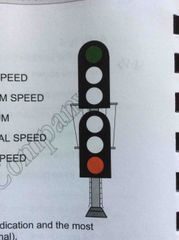
Interpret this signal. |
Home signal at Clear normal speed. The track section ahead is clear and the train may proceed at normal speed. The next fixed signal is displaying an indication allowing normal speed to continue. |
|
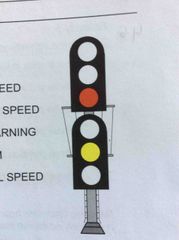
Interpret this signal. |
Medium speed warning. The track section ahead is clear but the speed of the train must not exceed 40km/h. The driver must be prepared to stop at the next fixed signal. |
|

Interpret this signal. |
Three position dwarf at Clear low speed. The section of line ahead is clear, but the driver must proceed at Low Speed (15km/h max) The next fixed signal is displaying a proceed indication. |
|
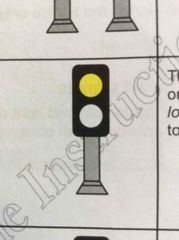
Interpret this signal. |
Low speed caution. The section of line may be occupied or obstructed. The driver must proceed at Low Speed (15km/h max) and be prepared to stop short of any obstruction. |
|
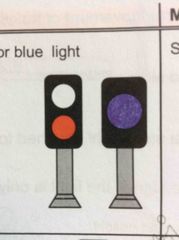
Interpret this signal. |
Dwarf signal at Stop. Red/blue/purple. |
|
|
Where are the only controlled automatic signals on the standard gauge Network? |
Inverleigh siding 100.6km post. Stawell 241.2km post. Glenorchy 261.6km post. Marmalake (down) 296.4km post. |

